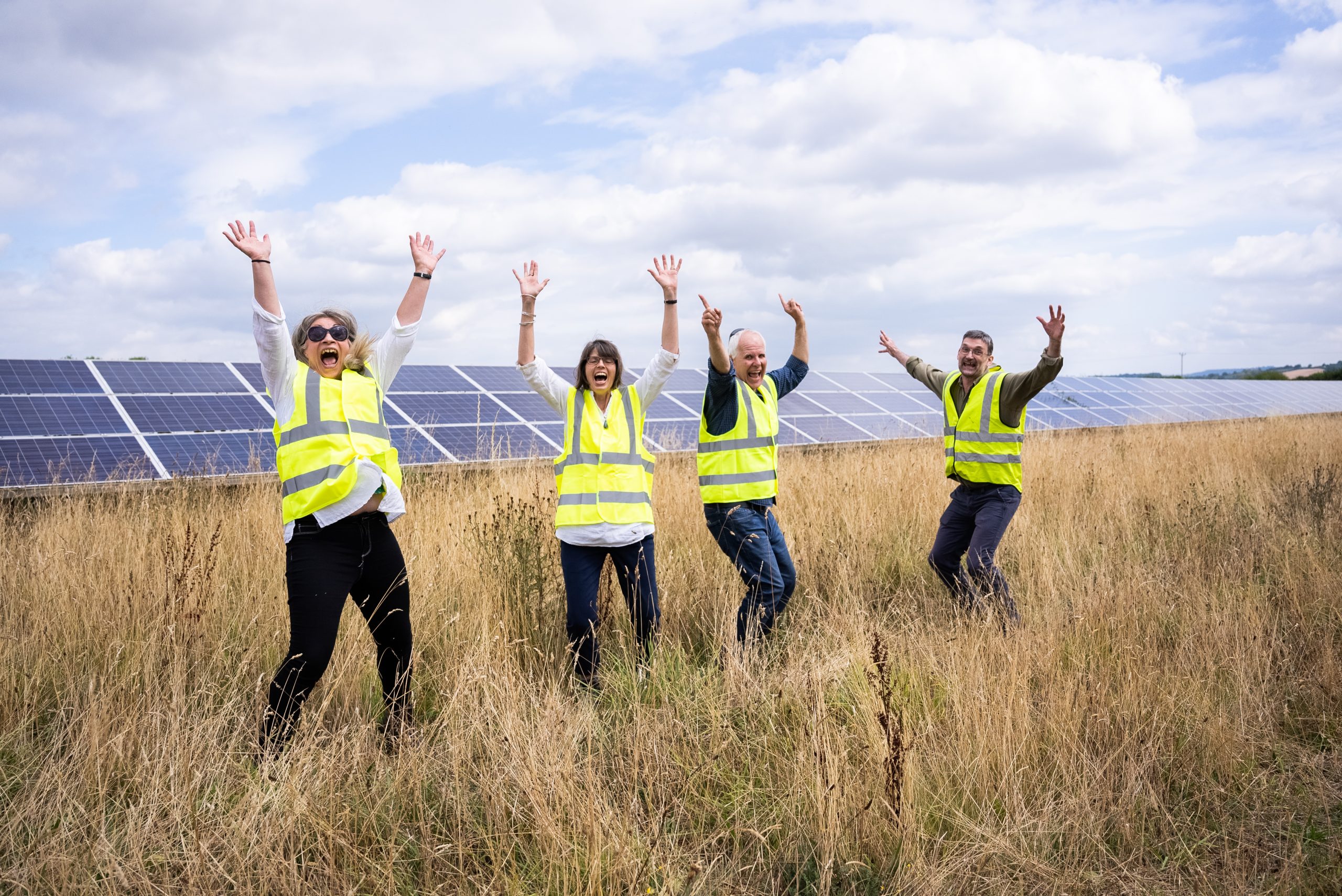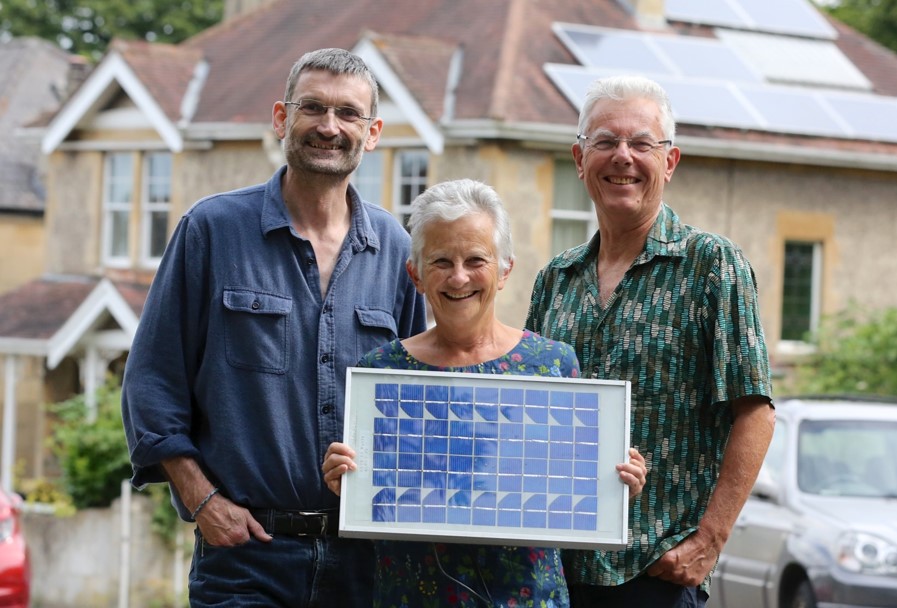What's the offer?
If you would like solar pv panels on your roof, BWCE offers an arrangement where we:
- Raise the total cost of the solar pv installation from a community fund-raise so there is no capital outlay for you.
- Sell the solar pv-generated electricity to you at an agreed discounted index-linked rate, thus delivering energy cost savings to you.
- Provide a well-tested lease and Power Purchase Agreement (see next question).
- Undertake all of the pre-installation development activities. application for a Certificate of Lawful Development or planning permission application.
- Manage the complete procurement and installation of the pv project, including structural and asbestos surveys.
- Use the revenue from the sale of the pv-generated electricity to you to make interest payments and investment repayments to the BWCE investors.
- Allocate profits to an independent community fund to support local community groups to deliver projects to cut carbon emissions and reduce fuel poverty.
- Highlight the energy actions of all our Community Partners on our website, newsletter and in our publications.
What is a Power Purchase Agreement (PPA)?
A Power Purchase Agreement is an agreement between you (the building owner) and BWCE where you agree to buy the solar power at an agreed rate (plus inflation) for the term of the lease.
What are the benefits to me?
- A reduction in your electricity bills now and in the future. Because you will be purchasing the electricity generated from the pv panels on your roof at a lower cost than the cost of purchasing electricity from an energy supplier, your electricity bills will go down. The discounted tariff set in the PPA will be fixed with an annual rise linked to inflation. As a result, you will also be protected from any above inflation increase in electricity prices in the future.
- A reduction in your carbon dioxide emissions. Because you will be reducing the amount of electricity you will be purchasing from the grid and replacing it with a truly renewable source of electricity, you will be lowering your carbon footprint and your impact on climate change.
- An opportunity to support your local community. Because the income from the solar panels on your roof, over and above member repayments, will go to the community fund, it will be a great opportunity for you to directly support local community projects.
- Hassle-free power generation. Because you are working with BWCE, it will be BWCE’s responsibility to operate and maintain the solar pv array. BWCE will provide insurance and manage the Operation and Management (O&M) Contract, which includes continuous remote monitoring, the annual electrical checks and cleaning of the panels, with inverter replacement between year 10 and year 15.
- An investment opportunity. Your organisation and any individual involved in it will have the opportunity to become a BWCE member by investing in the project on your roof and receive an annual interest payment of up to 4%.
How do I know if my building is suitable for community funded solar?
We need to check whether your building and roof is suitable for installing solar pv panels. The following is a list of the factors we will consider when assessing the suitability of your building and roof and we will ask you for help with providing some of the information to do this.
- Minimum on-site electrical demand: for the solar pv installation to be financially viable, the electricity generated must be used in your building in real-time i.e. we do not want to ‘export’ it to the grid.
- Freehold ownership: you must have freehold ownership of the building and be the occupier or user, with no intention of selling the building in the short term; or, if you are a tenant, you must have the prior agreement of the landlord to enter into a lease with BWCE.
- Refurbishment: there is no intention to refurbish or redevelop the property where the pv panels are required to be permanently removed.
- Electrical supply: preferably a three-phase electricity supply.
- Roof orientation: the panels need to be on a Southerly facing roof. If you have shallow pitched roofs facing East-West it may be possible to install on both pitches.
- Roof pitch: a 10-40° roof angle is preferable for maximum yield.
- Roof size if sloping: generally, only medium to large systems of at least 50kW are financially viable for our funding model. The roof area needed for a 50kW installation is approximately 280m². For a 250kW installation, the roof area required is approx. 1,500m².
- Roof size if flat: we will consider flat roofs for an east west solar system with a minimum roofspace of 650-700m².
- Roof material: steel framed-roofs or concrete roofs are preferable, and roofs with standing seams are a good option since it is straightforward to securely clamp the panel to the seam. Fixing methods we use minimise the penetration of roofs to ensure the integrity of the roof is not compromised and roof warranties remain valid. Felt roofs or roofs with asbestos are unsuitable.
- Roof age: a newer roof is preferable to an older roof because the solar pv installation will be in place for at least 20 years and dismantling the system to allow for roof maintenance will be costly.
- Roof structure: a structural survey will be required (arranged by BWCE) to ensure that the roof can accommodate the weight of the panels and to tolerate wind and snow loads.
- Roof access: a safe means of access to the roof during installation (plus for future maintenance) is required. A small working area for a telehandler and a small compound for off-loading panels will be needed close to the building.
- Roof shading: chimneys, roof vents, foliage, poles and wires can cast a shadow across the panels which will interfere with the generation potential. These sources of shading (and who owns them) need to be taken into account when calculating the size of roof area available for a pv installation. We can consider sites with trees provided you are willing to cut them back regularly or remove them to prevent overshading.
In addition to the roof itself, there are some non-roof aspects that need to be considered:
- Inverter location: this is a box near the panels that changes (inverts) the DC current generated from the panels into AC for the grid. Inverters should be sited as close as possible to the generating pv panels to reduce the cost and risks of DC cabling, so space is required near the roof area to house the inverters.
- Meter location: the generation meter is ideally placed close to the incoming grid supply meter, so room in the building’s existing meter cupboard would be useful, although not essential.
- Energy Performance Certificate: the building will need to have a valid Energy Performance Certificate (EPC).
- Monitoring performance: wi-fi access or a hard-wired connection to your internet service is needed to enable us to monitor the system performance and to auto generate PPA invoices. This avoids having to access your site for quarterly meter readings.
What will BWCE do to assess if Rooftop Solar is viable for me?
We will arrange a site visit to undertake an initial assessment of the potential for pv on your roof. This assessment will be at no cost to you and with no obligation and will include:
- A potential pv layout, showing installed system size and generation output.
- A financial analysis showing the estimated on site consumption, the savings to you by offsetting the current grid supplied electricity and a guide to the cost per unit you might pay for the solar power the array generates for you.
- An estimate of the surplus to the community fund.
What happens if I agree to have Rooftop Solar installed?
Following BWCE’s site visit and initial assessment, and following our discussion with you on the agreed potential benefits of the proposed project on your roof, BWCE will invite our preferred installers to a site visit to prepare quotes for installation.
Following the appointment of the chosen installer, BWCE will work with this installer to:
- Apply to the Distribution System Operator (DSO) for a grid connection agreement.
- Prepare layout drawings for an application to the Planning Authority (Bath & North East Somerset Council) for a Lawful Development Certificate.
Once approvals from the DSO and B&NES have been received, BWCE will:
- Agree with you our proven standard roof lease.
- Instruct our solicitor to undertake all title searches.
- Work closely with the installer to agree detailed pv layouts, including a structural and load assessment, a shading analysis, panel fixing requirements, cable runs, meter and inverter location diagrams, roof access arrangements, and provision of warranties.
- Agree the full design, supply and installation contract with the installer, including risk and method statements to be used during installation.
- Arrange for an EPC assessment if your building doesn’t currently hold a valid one.
- Agree with you our proven Power Purchase Agreement (PPA).
- Project manage the installation with the installer.
- Manage the Operations & Maintenance schedule over the lifetime of the project.
Will a full planning application be required?
A full planning application is normally only required if:
- The panels are raised on A frames i.e. on a flat roof, and the frames are higher than the highest part of the flat roof (excluding chimneys) OR
- The panels are to be installed on a building that is within the grounds of a listed building or on a site designated as a scheduled monument OR
- Your property is in a conservation area, or in a World Heritage Site, and the panels will be fitted to a wall which fronts a highway.
I’m interested what do I do next?
Contact our Rooftop Solar team to assess if your building is suitable for community funded solar.


